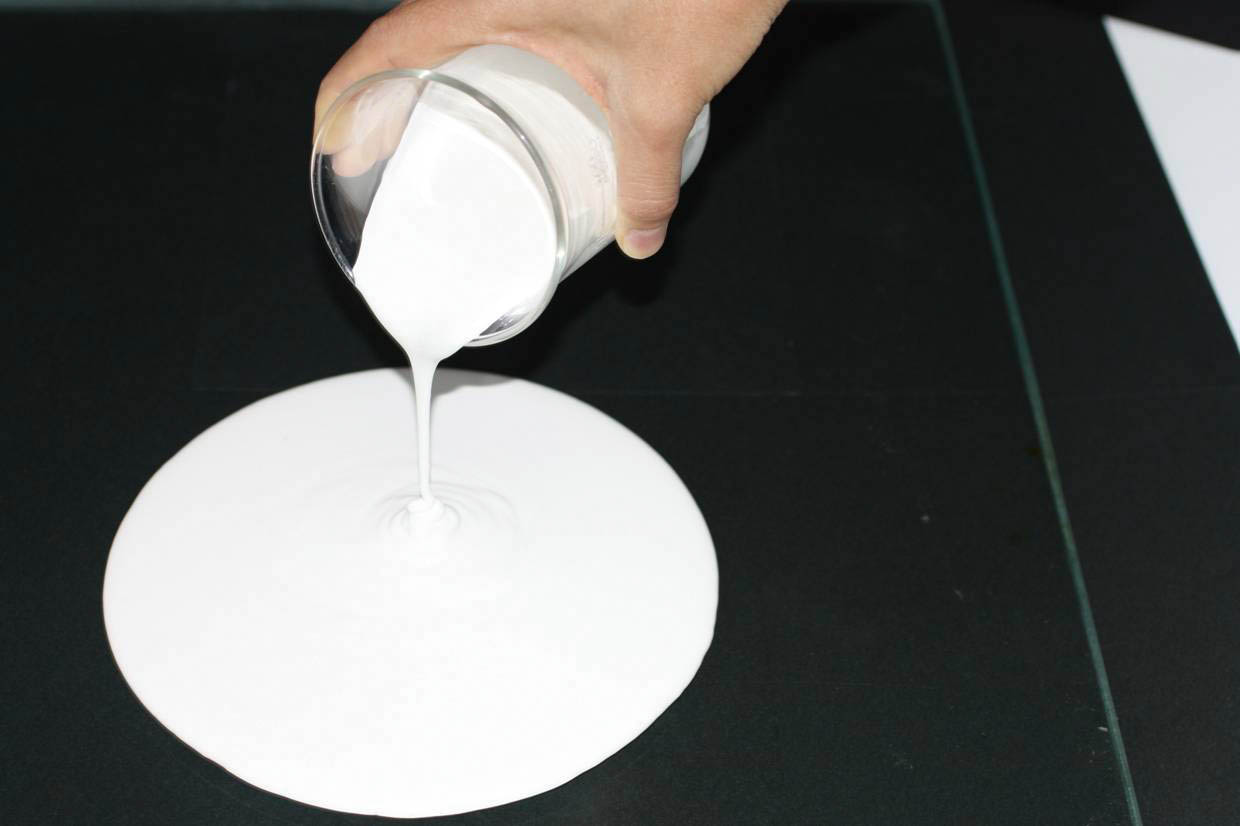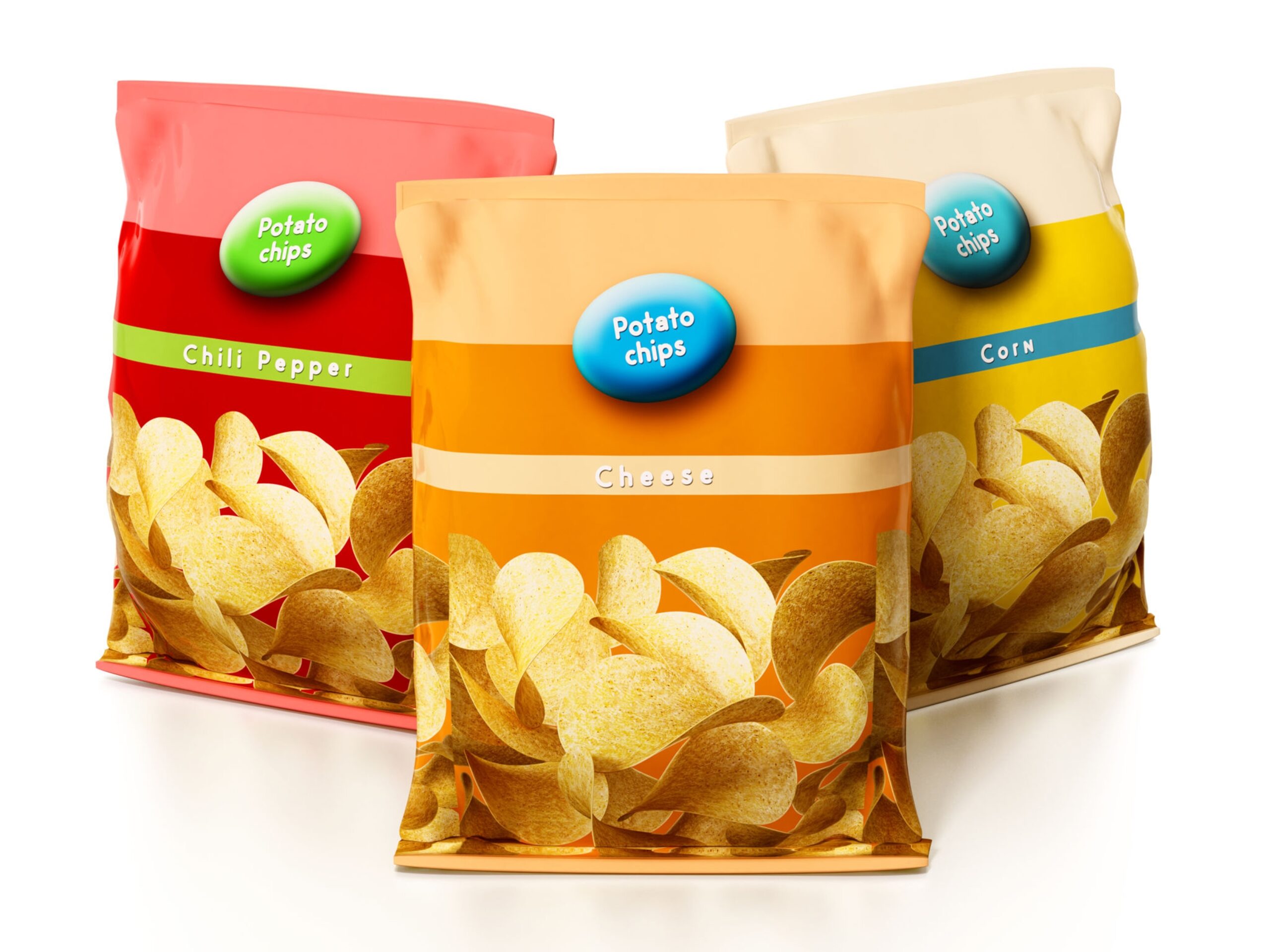Water Solubility
Nichigo G-Polymer™ has excellent water solubility. By controlling crystallinity, water solubility can also be controlled.
Procedure for Dissolving Nichigo G-Polymer™
Water Solubility (compared to PVOH)
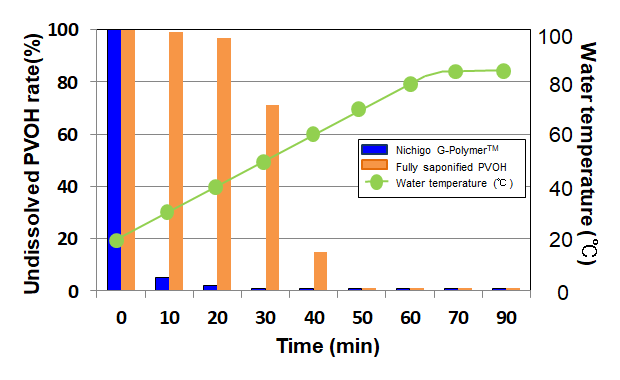

[Test conditions]
After dispersing Nichigo G-Polymer™ or fully saponified PVOH in water while stirring, heat the solution until dissolution.
Temperature: Raise from 20°C to 85°C (1°C/min)
Concentration: 10%
Water Solubility (comparison by grade)
Note that the dissolution time varies depending on the dispersion state of Nichigo G-Polymer™ and stirring conditions.
| Grade | Solubility Temp. / Time | ||
| 20℃ / 2hr | 70℃ / 1hr | 90℃ / 1hr | |
| Nichigo G-Polymer™ AZF8035Q | Dissolve | Dissolve | Dissolve |
| Fully saponified PVOH | Partially dissolve | Partially dissolve | Dissolve |
[Test conditions]
After dispersing Nichigo G-Polymer™ in water while stirring, heat the solution to the dissolution temperature. After stirring the solution for a specified time period, cool it to check the dissolution state.
Test concentration: 5%
Solubility in Other Solvents
Nichigo G-Polymer™ does not dissolve in most organic solvents.
This polymer exhibits solubility or partial solubility in organic solvents including ethylene glycol, triethylene glycol, glycerin, acetamide, dimethylacetamide and dimethyl sulfoxide.
It also dissolves in mixed solutions of water and lower alcohol.
Organic solvents
| Solvent | Appearance after dipping | Weight / Strength |
| Water | Dissolved | Decrease / Decrease |
| Methanol | Unchanged | Slight increase / Decrease |
| Acetone | Unchanged | Unchanged / Unchanged |
| Ethyl acetate | Unchanged | Unchanged / Unchanged |
| Methyl ethyl ketone | Unchanged | Unchanged / Unchanged |
| Toluene | Unchanged | Unchanged / Unchanged |
Sample: Nichigo G-Polymer™ BVE8049Q film
Test temperature: 23°C
Water-alcohol solution
| Concentration | Tolerance of Ethanol (wt%) | |
| Nichigo G-Polymer™ | PVOH | |
| 2wt% aqueous solution | 58 | 58 |
| 6wt% aqueous solution | 55 | 31-36 |
Nichigo G-Polymer™: fully saponified
[Test conditions]
Gradually add ethanol to resin aqueous solution while stirring and evaluate the amount added until precipitation (white turbidity) occurs.
Aqueous Solution Characteristics
Low foaming
Due to its molecular structure, Nichigo G-Polymer™ has excellent low foaming characteristics in aqueous solutions.
Aqueous solutions with excellent workability can be achieved without adding antifoaming agent.
Foaming comparison with PVOH
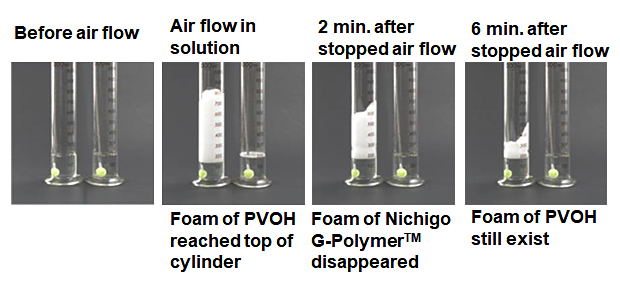
Right: Nichigo G-Polymer™ (fully saponified)
Left: PVOH (fully saponified)
[Test method]
Add a 1% aqueous solution (200 mL) into a 1L graduated cylinder, blow in 300 cc/min of air through a sparger, and observe the height of the foam over time.
Viscosity stability of aqueous solution
Storage stability of aqueous solution at low temperatures
Aqueous solutions of Nichigo G-Polymer™ demonstrate excellent viscosity stability when stored at low temperatures.
By controlling crystallinity, the viscosity of the aqueous solution can also be controlled.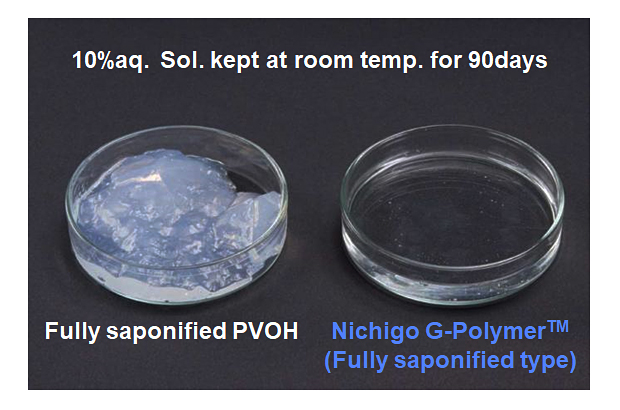
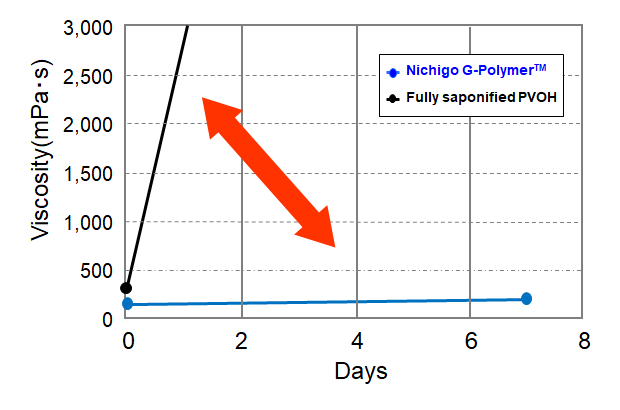
Nichigo G-Polymer™: fully saponified
10% aqueous solution stored at 5°C, viscosity measurement: Brookfield viscometer, 10 rpm
Viscosity stability under high shear conditions
Nichigo G-Polymer™ aqueous solution exhibits resistance to the occurrence of flow abnormalities even under high shear conditions.
Therefore, application to high-speed coating and other purposes is expected.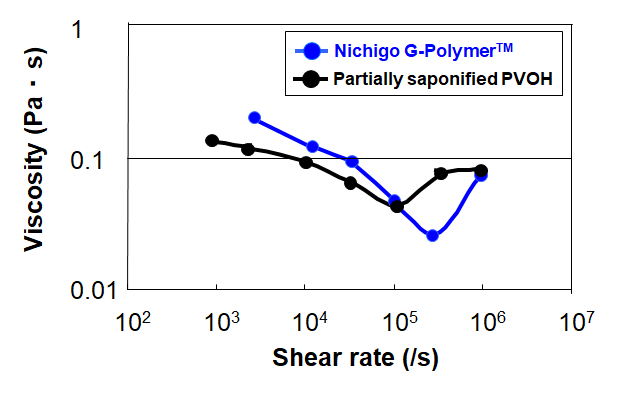
Partially saponified PVOH, degree of saponification: 88 mol%
[Measurement]
Capillary rheometer, 7.5% aqueous solution
Stability in alkaline aqueous solutions
Nichigo G-Polymer™ is stable and resists changes in viscosity even in highly concentrated alkaline aqueous solutions.
[Test method]
Mix 12% resin aqueous solution and 20% NaOH aqueous solution 1:1.
Observe the solution state after leaving at 23°C for 3 days.
Dissolution state when dissolving each resin in 10% NaOH aqueous solution
| Samples | Just after dissolved | After 1 day | After 1 week |
| Nichigo G-Polymer™ AZF8035Q | Dissolve | Dissolve | Dissolve |
| Partially saponified PVOH | Partially dissolve | Gelation | Gelation |
| Fully saponified PVOH | Partially dissolve | Gelation | Gelation |
[Conditions]
Polymer concentration: 6%
Dissolution condition : 90°C, 1 hr
Storage temperature : 40°C
Viscosity was measured at different pHs when stored at 5°C and at 23°C.
Fully saponified PVOH stored at 5°C formed a gel in one day. In contrast, the viscosity of Nichigo G-Polymer™ remained stable regardless of pH.
Viscosity stability of aqueous solutions over time
| Samples | pH | Viscosity of aqueous solution (mPa・s) | |||
| 5℃ | 23℃ | ||||
| Initial | 1 month later | Initial | 1 month later | ||
| Nichigo G-Polymer™ | 3.0 | 170 | 170 | 110 | 110 |
| 8.0 | 170 | 180 | 110 | 110 | |
| 13.0 | 160 | 180 | 110 | 110 | |
| Fully saponified PVOH | 3.0 | 200 | Gelation | 120 | 130 |
| 8.0 | 190 | Gelation | 120 | 130 | |
| 13.0 | 230 | Gelation | 120 | 140 | |
[Test method]
Measured the viscosity of a 7% aqueous solution at a pH adjusted to 3.0 with 10% acetic acid aqueous solution and to 8.0 and 13.0 with 10% NaOH aqueous solution, after storage at 5°C and 25°C for one month
Alcohol tolerance
Nichigo G-Polymer™ also dissolves in aqueous solutions containing a large amount of lower alcohol.
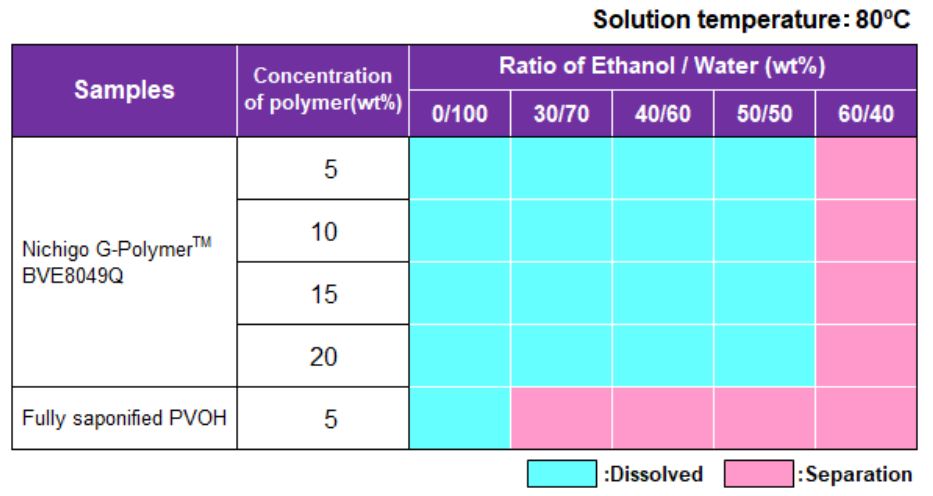
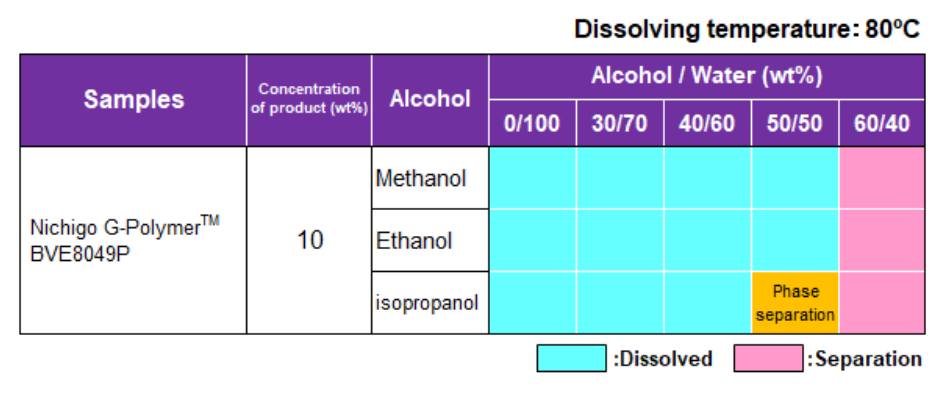
Surface tension
Nichigo G-Polymer™ aqueous solution demonstrates high surface tension compared to PVOH.
Water Resistance
Water resistance
Addition of a crosslinker
While Nichigo G-Polymer™ is a resin with outstanding water solubility, water resistance can be achieved by using it with a crosslinker.
Nichigo G-Polymer™ also has high crosslinking performance compared to PVOH.


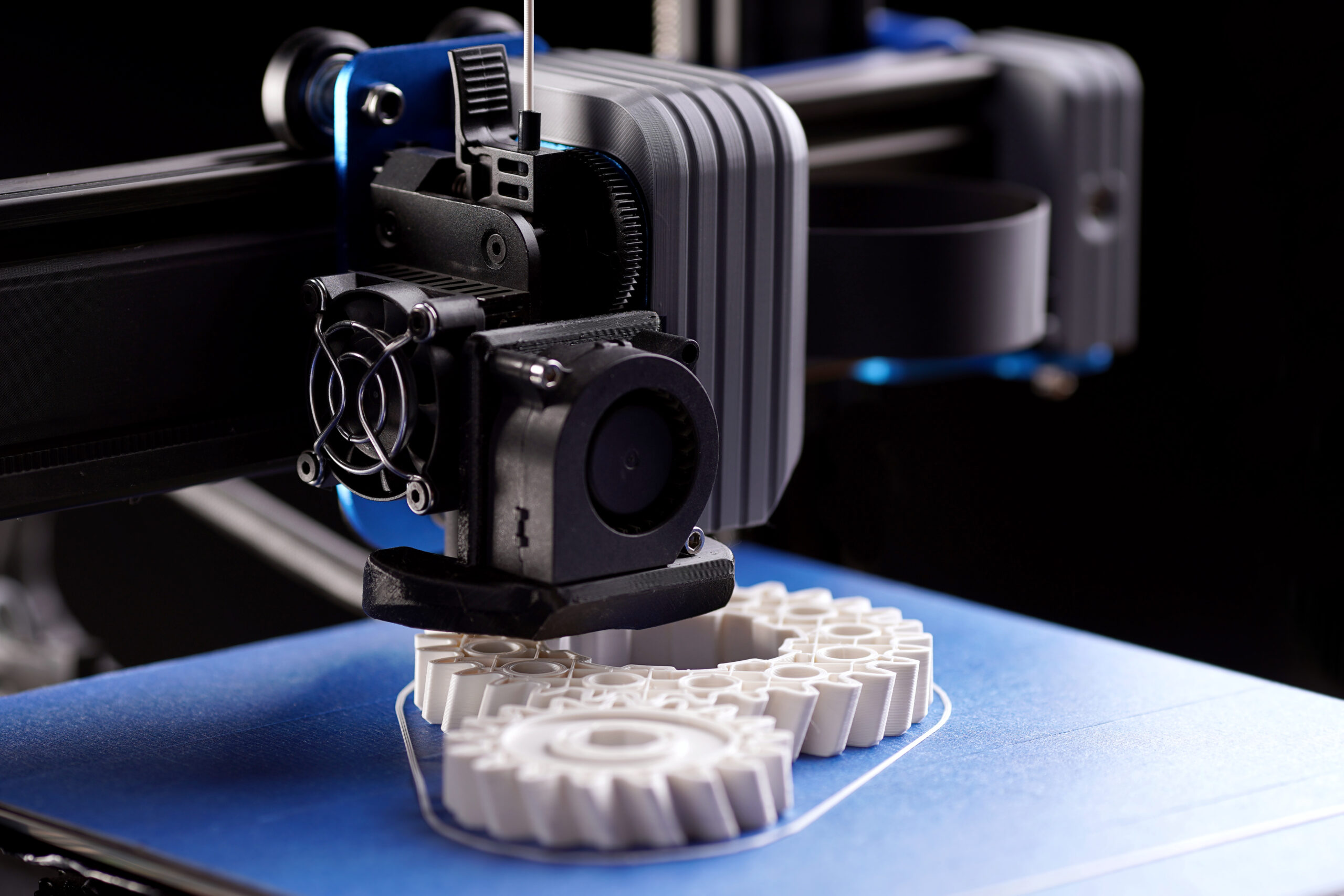


-scaled.jpg)

